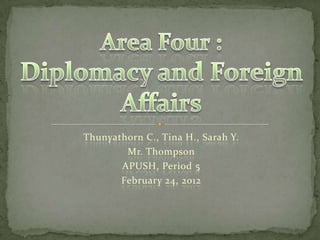Area four Period 5
•Transferir como PPTX, PDF•
1 gostou•469 visualizações
Denunciar
Compartilhar
Denunciar
Compartilhar

Recomendados
Recomendados
Mais conteúdo relacionado
Mais procurados
Mais procurados (20)
FLASH REVISE CARDS - THE DISARMAMENT COMMISSION OF THE LEAGUE OF NATIONS

FLASH REVISE CARDS - THE DISARMAMENT COMMISSION OF THE LEAGUE OF NATIONS
Destaque
Destaque (20)
American Revolution and Critical Period Through Maps

American Revolution and Critical Period Through Maps
Semelhante a Area four Period 5
For lecture videos, readings, and other class materials, you can sign up for this independent study course at academy.mises.org.The Real Causes of America's Wars, Lecture 4 with David Gordon - Mises Academy

The Real Causes of America's Wars, Lecture 4 with David Gordon - Mises AcademyThe Ludwig von Mises Institute
Semelhante a Area four Period 5 (20)
UNIT 4-ROARING 20'S-A STUDY INTO THE AMERICAN HISTORY

UNIT 4-ROARING 20'S-A STUDY INTO THE AMERICAN HISTORY
The Real Causes of America's Wars, Lecture 4 with David Gordon - Mises Academy

The Real Causes of America's Wars, Lecture 4 with David Gordon - Mises Academy
The aims of the participants at the Paris Peace Conference.pdf

The aims of the participants at the Paris Peace Conference.pdf
Mais de ushistorythompson
Mais de ushistorythompson (20)
Último
Mehran University Newsletter is a Quarterly Publication from Public Relations OfficeMehran University Newsletter Vol-X, Issue-I, 2024

Mehran University Newsletter Vol-X, Issue-I, 2024Mehran University of Engineering & Technology, Jamshoro
Último (20)
Food safety_Challenges food safety laboratories_.pdf

Food safety_Challenges food safety laboratories_.pdf
Mixin Classes in Odoo 17 How to Extend Models Using Mixin Classes

Mixin Classes in Odoo 17 How to Extend Models Using Mixin Classes
Kodo Millet PPT made by Ghanshyam bairwa college of Agriculture kumher bhara...

Kodo Millet PPT made by Ghanshyam bairwa college of Agriculture kumher bhara...
Micro-Scholarship, What it is, How can it help me.pdf

Micro-Scholarship, What it is, How can it help me.pdf
General Principles of Intellectual Property: Concepts of Intellectual Proper...

General Principles of Intellectual Property: Concepts of Intellectual Proper...
This PowerPoint helps students to consider the concept of infinity.

This PowerPoint helps students to consider the concept of infinity.
Area four Period 5
- 1. Thunyathorn C., Tina H., Sarah Y. Mr. Thompson APUSH, Period 5 February 24, 2012
- 2. Proposed by the Secretary of State Charles Evans Hughes. An attempt to prevent the naval armaments race between America, Britain, and Japan by reducing dramatically the fleets of the 3 nations and a 10-year suspension on constructing of large warships. Limits for total naval tonnage and a ratio of armaments. Nations: U.S., Great Britain, France, Italy and Japan Pledging a continuation of the Open Door policy in China The respect of one another’s Pacific territories and cooperate to prevent aggression Nations: U.S., Great Britain, France, and Japan
- 3. The Dawes Plan Responded to the economic crisis in Germany In 1924, Charles G. Dawes, an American banker, negotiated an agreement under which American banks would provide enormous loans to the Germans to help them to pay for their reparations. In return, Britain and France would agree to reduce the amount of those payment. Dawes won the Nobel Peace Prize for his plan. The Plan was accepted by Germany and the Triple Entente and went into effect in September 1924. Result: Short term economic benefits to the German economy. Softened the burdens of war reparations, stabilized the currency, and brought increased foreign investments and loans to the German market.
- 4. Result of the Dawes Plan (cont.) Led to a circular pattern in international finance. German economy became dependent on foreign markets and economies and therefore problems with the U.S. economy (e.g. the Great Depression) would later severely hurt Germany as it did the rest of the western world, which was subject to debt repayments for loans of American dollars. Led to the creation of the Young Plan in 1929. The Young Plan Was written in 1929 and formally adopted in 1930. Presented by the committee headed (1929-30) by American Owen D. Young. It reduced further payments to 112 billion Gold Marks, US $8 billion in 1929 (US $108 billion) over a period of 59 years (1988). It divided the annual payment, set at two billion Gold Marks (US $473 million.
- 6. Economic expansion in Latin America: U.S. investments in Latin America more than doubled between 1924 and 1929. American corporations built roads and other facilities in many areas. American banks were offering large loans to Latin American government. Good Neighbor Policy: With A Good Neighbor Policy US reassuring Mexico and other Latin American countries that it would not intervene in their domestic matters. Latin America was one of the most important targets of the new policy of trade reciprocity. It created a new American attitude toward intervention: In 1933 at the Inter-American Conference in Montevideo, Secretary of State Hull signed a formal conference declaring: “No state has the right to intervene in the internal or external affairs of another.” Instead of to use military force to compel Latin American governments to repay debts, the new reliance on economic pressures eased tensions between the United States and its neighbor.
- 7. In 1927, French foreign minister Aristide Briand asked the US to join an alliance against Germany and proposed a peace pact to outlaw between the U.S. and France. Frank B. Kellogg, the U.S. Secretary of State, responded with a proposal for a multilateral pact against war open for all nations. Significance: Renounced war, prohibiting the use of war as “an instrument of national policy.” Called upon signatories to settle their disputes by peaceful means. Served as the legal basis for the creation of the notion of crime against peace. Signed in Paris on August 28, 1928 by 14 nations, later joined by 48 other nations.